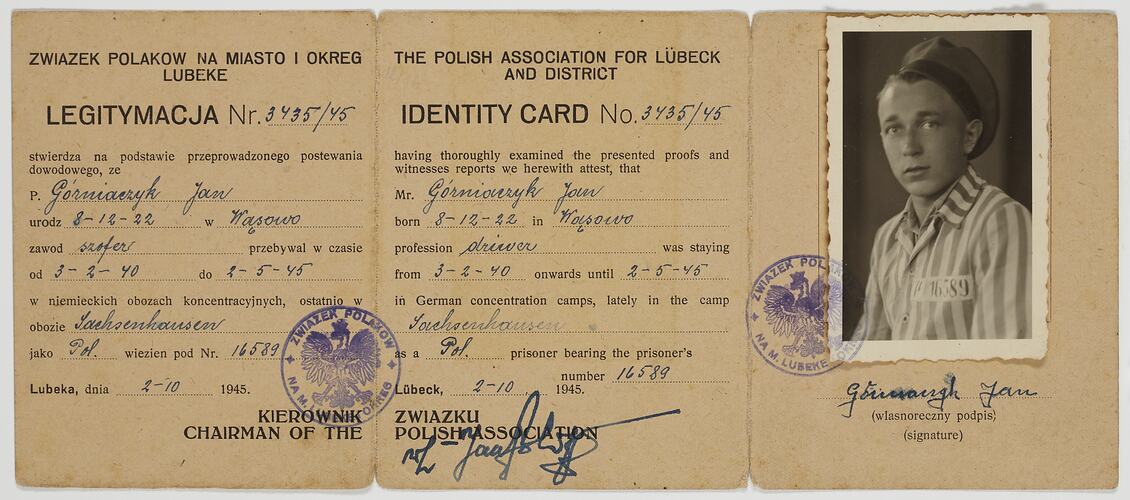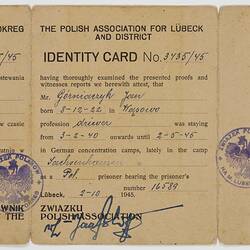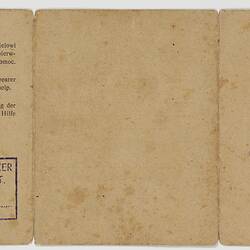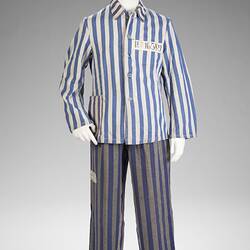Summary
Cardboard identity card issued to Jan Gornia following his release from a Nazi concentration camp at the end of World War II. Mr Johann (Jan) Gorniaczyk (Gornia) was detained between 3 February 1940 and May 1945 in Nazi concentration camps and the photograph inside the card shows Jan wearing the uniform also in the collection.
Mr Gornia was born 8 December 1922 in Wasowo, Poland. He spent his imprisonment in Sachsenhausen, Oranienburg in Germany as a non-Jewish political prisoner, number 16589. The inverted red triangle indicates that, according to the Nazi system of prisoner classification, that Mr Gornia was a political prisoner. It is believed that he was incarcerated because his father or uncle had been involved in the Polish uprising against Germany after World War I.
Mr Gornia met his Polish wife Mira in postwar Germany; she had been forcibly taken to a labour camp in Germany and she worked as a nurse in a hospital after the War. Jan and Mira married in Germany and migrated together to Australia in 1949, bringing with them his uniform, along with other war memorabilia. It was then that he officially shortened his name. Mr and Mrs Gornia had one son and lived the majority of their lives in Yarraville, Melbourne. Jan was highly skilled with his hands and worked for Holden.
Physical Description
Identity card made from light brown coloured cardboard. Unfolded the identity card has six faces - three faces on the front, and three on the back. The card is meant to be folded and placed inside its plastic pouch when carried. The front of the card identifies its holder in Polish and English, and has a black and white portrait photograph attached to it of Mr Jan Gorniaczyk, who is shown wearing his concentration camp uniform. The back of the card explains that the holder has been liberated from his imprisonment, and should receive privilege and help. The accompanying flexible and transparent plastic pouch is slightly larger than the folded identity card. It is sealed at the sides and opens at one of its longer ends. It has a half oval cutout at the opening for ease of access.
Significance
This collection of wartime memorabilia holds enormous historical significance. These pieces highlight how the Holocaust has involved the lives of innumerable non-Jewish Poles, who experienced incredible levels of inhumanity while imprisoned in concentration and labour camps in Europe. Although the Jewish Holocaust experience is well documented, discourse surrounding the non-Jewish experience is not as prevalent. These pieces help tell this story. Additionally, this collection aids in the understanding of post war migration to Australia, in this case, of the Polish community to Melbourne.
More Information
-
Collecting Areas
-
Acquisition Information
Donation from Mrs Mira Gornia, 28 May 2010
-
Issued To
Mr Jan Gornia, Lubeck, Northern Germany, Schleswig-Holstein, Germany, 2 Oct 1945
-
Issued By
Polish Association for Lubeck & District, Lubeck, Northern Germany, Schleswig-Holstein, Germany, 2 Oct 1945
-
Inscriptions
The card has inscriptions on all of its six faces, except for the second face of the back side. The text is half printed in black ink and half handwritten in blue ink. Front side, first face: ZWIAZEK POLAKOW NA MIASTO I OKREG LUBEKE / LEGITYMACJA NR. 3435/45 / stwierdza na podstawie przeprowadzonego postewania dowodowego, ze P. Gorniaczyk Jan urodz 8-12-22 w Wasowo zawod szofers przebywal w czasie w niemieckich obozach koncentracyjnych, ostatnio w obozie Sachsenhauser jako Pol. wiezien pod Nr. 16589 / Lubeka, dnia 2-10 1945. Front side, second face: THE POLISH ASSOCIATION FOR LUBEKE AND DISTRICT / IDENTITY CARD No. 3435/45 / having thoroughly examined the presented proofs and witnesses reports we herewith attest, that Mr. Gorniaczyk Jan born 8-12-22 in Wasowo profession driver was staying from 3-2-40 onwards until 2-5-45 in German concentration camps, lately in the camp Sachsenhausen as a Pol. prisoner bearing the prisoner's number 16589 / Lubeck 2-10 1945. Front side, spanning over the first and second face: KIEROWNIK ZWIAZKU / CHAIRMAN OF THE POLISH ASSOCIATION (ILLEGIBLE SIGNATURE). Front side, third face: Round purple stamp of an outstretched bird over the black and white photograph of Mr. Gorniaczyk. The stamp reads: ZWIAZEK POLAKOW / NA M. LUBREKE / Gorniaczyk Jan / (wlasnoreczny podpis) (signature). Back side, first face: Typed text: Na zarzadzenie Wladz Wojskowych okazicielowi niniejszego dowodu przysluguje prawo pierwszenstwa. Nalezy mu okazywac wszelka pomoc. / By order of the Military Government the bearer of this pass must receive privilege and help. / Inhaber dieses Passes ist auf Anordnung der Mil.- Behorde zu bevorzugen. Ihn ist jede Hilfe zu gewahren. / Stamped black text: POLISH LIAISON OFFICER 626 MIL. GOV./R/D(Illegible letter)T. / (Illegible signature) Back side, second face: No inscriptions. Back side, third face: Blue stamped text: Oswobodzony przez Aliantow / Liberated by Allies.
-
Classification
-
Category
-
Discipline
-
Type of item
-
Overall Dimensions - Open
260 mm (Width), 110 mm (Height)
1. Open 2. Folded 3. Attached photo 4. Plastic pouch
-
Overall Dimensions - Closed
85 mm (Width), 110 mm (Height)
1. Open 2. Folded 3. Attached photo 4. Plastic pouch
-
Image Dimensions - Photograph
50 mm (Width), 80 mm (Height)
1. Open 2. Folded 3. Attached photo 4. Plastic pouch
-
Other Dimensions
90 mm (Width), 135 mm (Height)
Overall dimension for the plastic pouch.
-
References
Martin Gilbert, Atlas of the Holocaust, Rainbird, 1982. Bill Niven, Facing the Nazi Past, Routledge, 2002 1st ed., p. 11 Evans, Richard J (2006). The Third Reich in Power. London: Penguin Books. pp. 255-256 Adam Lebor & Roger Boyes, Surviving Hitler, Simon & Schuster, pg. 230, 1st ed. 2000 Falk Pingel, Encyclopaedia of the Holocaust, New York: Macmillan, 1990, vol. 4, p.1321-1322 Foot & Langley, 'MI9 - Escape and Evasion 1939 - 1945', Book Club Associates, 1979 [Link 1] [Link 2] [Link 3] [Link 4] [Link 5] [Link 6]
-
Keywords
Brought Goods, Concentration Camps, Holocaust, Identity Cards, Polish Communities, Polish Immigration, World War II, 1939-1945



